I need to use black and white color for my boxplots in R. I would like to colorfill the boxplot with lines and dots. For an example:

I imagine ggplot2 could do that but I can't find any way to do it.
Thank you in advance for your help!
I need to use black and white color for my boxplots in R. I would like to colorfill the boxplot with lines and dots. For an example:

I imagine ggplot2 could do that but I can't find any way to do it.
Thank you in advance for your help!
I thought this was a great question and pondered if it was possible to do this in base R and to obtain the checkered look. So I put together some code that relies on boxplot.stats and polygon (which can draw angled lines). Here's the solution, which is really not ready for primetime, but is a solution that could be tinkered with to make more general.
boxpattern <-
function(y, xcenter, boxwidth, angle=NULL, angle.density=10, ...) {
# draw an individual box
bstats <- boxplot.stats(y)
bxmin <- bstats$stats[1]
bxq2 <- bstats$stats[2]
bxmedian <- bstats$stats[3]
bxq4 <- bstats$stats[4]
bxmax <- bstats$stats[5]
bleft <- xcenter-(boxwidth/2)
bright <- xcenter+(boxwidth/2)
# boxplot
polygon(c(bleft,bright,bright,bleft,bleft),
c(bxq2,bxq2,bxq4,bxq4,bxq2), angle=angle[1], density=angle.density)
polygon(c(bleft,bright,bright,bleft,bleft),
c(bxq2,bxq2,bxq4,bxq4,bxq2), angle=angle[2], density=angle.density)
# lines
segments(bleft,bxmedian,bright,bxmedian,lwd=3) # median
segments(bleft,bxmin,bright,bxmin,lwd=1) # min
segments(xcenter,bxmin,xcenter,bxq2,lwd=1)
segments(bleft,bxmax,bright,bxmax,lwd=1) # max
segments(xcenter,bxq4,xcenter,bxmax,lwd=1)
# outliers
if(length(bstats$out)>0){
for(i in 1:length(bstats$out))
points(xcenter,bstats$out[i])
}
}
drawboxplots <- function(y, x, boxwidth=1, angle=NULL, ...){
# figure out all the boxes and start the plot
groups <- split(y,as.factor(x))
len <- length(groups)
bxylim <- c((min(y)-0.04*abs(min(y))),(max(y)+0.04*max(y)))
xcenters <- seq(1,max(2,(len*(1.4))),length.out=len)
if(is.null(angle)){
angle <- seq(-90,75,length.out=len)
angle <- lapply(angle,function(x) c(x,x))
}
else if(!length(angle)==len)
stop("angle must be a vector or list of two-element vectors")
else if(!is.list(angle))
angle <- lapply(angle,function(x) c(x,x))
# draw plot area
plot(0, xlim=c(.97*(min(xcenters)-1), 1.04*(max(xcenters)+1)),
ylim=bxylim,
xlab="", xaxt="n",
ylab=names(y),
col="white", las=1)
axis(1, at=xcenters, labels=names(groups))
# draw boxplots
plots <- mapply(boxpattern, y=groups, xcenter=xcenters,
boxwidth=boxwidth, angle=angle, ...)
}
Some examples in action:
mydat <- data.frame(y=c(rnorm(200,1,4),rnorm(200,2,2)),
x=sort(rep(1:2,200)))
drawboxplots(mydat$y, mydat$x)

mydat <- data.frame(y=c(rnorm(200,1,4),rnorm(200,2,2),
rnorm(200,3,3),rnorm(400,-2,8)),
x=sort(rep(1:5,200)))
drawboxplots(mydat$y, mydat$x)

drawboxplots(mydat$y, mydat$x, boxwidth=.5, angle.density=30)

drawboxplots(mydat$y, mydat$x, # specify list of two-element angle parameters
angle=list(c(0,0),c(90,90),c(45,45),c(45,-45),c(0,90)))

EDIT: I wanted to add that one could also obtain dots as a fill by basically drawing a pattern of dots, then covering them a "donut"-shaped polygon, like so:
x <- rep(1:10,10)
y <- sort(x)
plot(y~x, xlim=c(0,11), ylim=c(0,11), pch=20)
outerbox.x <- c(2.5,0.5,10.5,10.5,0.5,0.5,2.5,7.5,7.5,2.5)
outerbox.y <- c(2.5,0.5,0.5,10.5,10.5,0.5,2.5,2.5,7.5,7.5)
polygon(outerbox.x,outerbox.y, col="white", border="white") # donut
polygon(c(2.5,2.5,7.5,7.5,2.5),c(2.5,2.5,2.5,7.5,7.5)) # inner box

But mixing that with angled lines in a single plotting function would be a bit difficult, and is generally a bit more challenging, but it starts to get you there.
I think it is hard to do this with ggplot2 since it dont use shading polygon(gris limitatipn). But you can use shading line feature in base plot, paramtered by density and angle arguments in some plot functions ( ploygon, barplot,..).
The problem that boxplot don't use this feature. So I hack it , or rather I hack bxp internally used by boxplot. The hack consist in adding 2 arguments (angle and density) to bxp function and add them internally in the call of xypolygon function ( This occurs in 2 lines).
my.bxp <- function (all.bxp.argument,angle,density, ...) {
.....#### bxp code
xypolygon(xx, yy, lty = boxlty[i], lwd = boxlwd[i],
border = boxcol[i],angle[i],density[i])
.......## bxp code after
xypolygon(xx, yy, lty = "blank", col = boxfill[i],angle[i],density[i])
......
}
Here an example. It should be noted that it is entirely the responsibility of the user to ensure that the legend corresponds to the plot. So I add some code to rearrange the legend an the boxplot code.

require(stats)
set.seed(753)
(bx.p <- boxplot(split(rt(100, 4), gl(5, 20))))
layout(matrix(c(1,2),nrow=1),
width=c(4,1))
angles=c(60,30,40,50,60)
densities=c(50,30,40,50,30)
par(mar=c(5,4,4,0)) #Get rid of the margin on the right side
my.bxp(bx.p,angle=angles,density=densities)
par(mar=c(5,0,4,2)) #No margin on the left side
plot(c(0,1),type="n", axes=F, xlab="", ylab="")
legend("top", paste("region", 1:5),
angle=angles,density=densities)